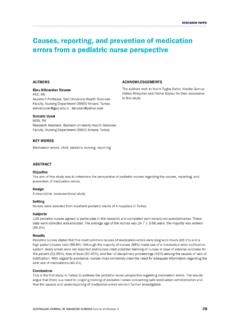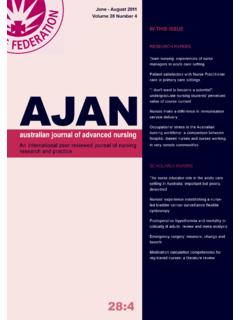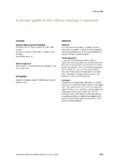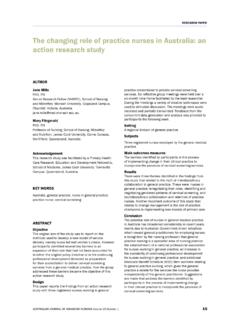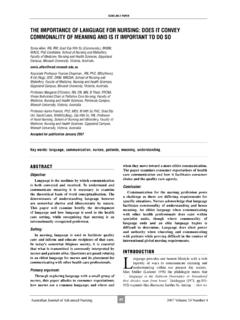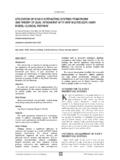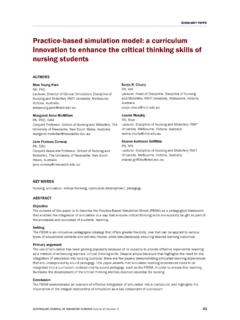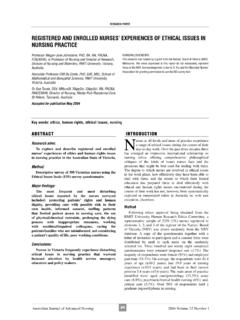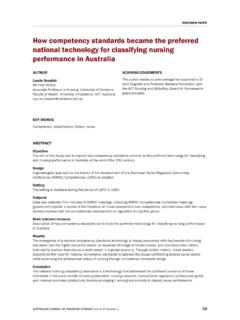Transcription of Nurses’ descriptions of changes in cognitive function in ...
1 AUSTRALIAN JOURNAL OF ADVANCED NURSING Volume 26 Number 121 Nurses descriptions of changes in cognitive function in the acute care settingRESEARCH PAPERAUTHORS Malcolm HareRN, BSc (Nursing) (Honours), Nurse Manager, Informatics Support, Fremantle Hospital; Research Associate, School of Nursing and Midwifery, Curtin University of Technology, Western Australia McGowanRN, (Nursing), Director Nursing Research and Evaluation, Fremantle Hospital; Adjunct Research Fellow, School of Nursing and Midwifery, Curtin University of Technology, Western AustraliaDianne WynadenRN, RMHN, PhD, Associate Professor, School of Nursing and Midwifery, Curtin University of Technology; Research Consultant (Mental Health), Adjunct Senior Research Consultant, Department of Nursing Research, Evaluation and Informatics, Fremantle Hospital, Western AustraliaGaye SpeedRN, (Nursing), PGradDip HAdmin, Nurse Consultant Clinical Improvement, Fremantle Hospital, Fremantle, Western AustraliaIan LandsboroughRN, RMHN, , Lecturer, School of Nursing and Midwifery, Curtin University of Technology, Western AustraliaKEY WORDS confusion, delirium, quality nursing care, dementia, cognitive functioning, clinical auditABSTRACTO bjectiveTo describe nurses documentation of cognition and behavioural changes in patients in acute care settings.
2 Hospitalised patients often present with multiple co morbidities including declining levels of cognitive functioning and this is particularly so for older people. Many older people will experience a delirium during hospitalisation. While prevention or prompt management of delirium is paramount to providing quality care, research suggests that health professionals regularly fail to differentiate between delirium and other cognitive changes in hospitalised audits of progress notes were completed over a four week period at a Western Australian tertiary hospital to identify, quantify and categorise cognitive and behavioural changes in hospitalised patients. This paper describes data on nurses documentation collected in the course of those audits. On four consecutive Thursdays, the medical records of all patients identified by nursing staff as being confused were reviewed.
3 Where no definitive cause for the confusion was documented, the case notes were examined for evidence of risk factors to determine a probable Western Australian tertiary medical records of all patients identified by nursing staff as being outcome measuresDocumentation in patient medical records of a patient having cognitive or behavioural changes or being confused; use of a cognitive screening tool; or a diagnosis of total of 1209 patients were surveyed over the four audit days with 183 patients (15%) being identified as confused. Confusion was the most common descriptor used by nurses to describe cognitive and behavioural changes ; in many cases it was the only term used. Many of these changes were indicative of delirium. Little use by any health professional of cognitive screening tools was and behavioural changes are a common problem in hospitalised patients who are elderly.
4 The use of the term confusion to describe a range of cognitive and behavioural changes is a barrier to accurate identification of delirium, which is often the first indicator of serious underlying JOURNAL OF ADVANCED NURSING Volume 26 Number 122 INTRODUCTIONThe international literature is critical of the widespread lack of recognition of delirium (Hustey et al 2003; Inouye et al 1999; Flacker and Marcantonio 1998). Nurses inability to recognise delirium was illustrated by a recent study on nurses level of knowledge of delirium and associated risk factors. The study reported that only 42% of nurses scored 70% or better on delirium knowledge questions and only of nurses scored 70% or better for knowledge of delirium risk factors (Hare 2006). It has also been suggested that knowledge deficits may be perpetuated because health professionals consistently and routinely document cognitive and behavioural changes under the encompassing term confusion , which does not allow for qualification or quantification of significant changes in a patient s functioning (Milisen et al 2002).
5 This practice continues even though prevention, or early intervention, for delirium has been shown to improve outcomes for this group of patients (Inouye et al 2005a).Delirium presents as an acute short term disturbance of consciousness lasting from a few hours to a few months characterised by disorganised thinking, perceptual disturbances and inattention (American Psychiatric Association 1999), and is often the first or only presenting sign of an underlying medical problem (Meagher 1998). Delirium causes cognitive and behavioural changes in a patient that fluctuate over the course of the day, can usually be attributed to a physiological cause and/or the use of substance(s), and is not better explained by a pre existing or evolving dementia (American Psychiatric Association 1999). Three main variants of delirium exist: hyperactive, hypoactive and mixed.
6 The hyperactive variant involves hyper vigilance with associated agitation and hallucinations (American Psychiatric Association 1999). Patients experiencing the hyperactive variant are more likely to have their condition recognised and receive early intervention due to their presenting behaviours (Breitbart et al 2002; O Keeffe 1999). Patients with the hypoactive variant often present as lethargic, drowsy and have difficulty focussing attention, and this form is more likely to go unrecognised. The mixed variant fluctuates between features of older people, delirium is a predictor of mortality and morbidity, but delirium and its underlying causes are commonly under diagnosed and as a consequence under treated (Douglas et al 2005; Cole 2004; Inouye et al 1999; O Keeffe 1999). This lack of recognition occurs in 25% of cases (Young and George 2003) increasing to when the patient has a pre existing dementia (Milisen et al 2002).
7 In addition, delirium in elderly patients often results in a decreased level of functioning post discharge from hospital, which impacts on the individual s future quality of life (Inouye et al 1998). Estimates suggest that delirium is present in up to 62% of hospitalised orthopaedic patients who are elderly (Olofsson et al 2005) rising to as high as 89% in patients who have a pre existing dementia (Fick et al 2002).Nurses are well placed to identify, assess and document cognitive and behavioural changes as they spend more time with patients than most other health professionals. This is especially important for older patients, who are at high risk of developing delirium (McCusker et al 2003; O Keeffe and Lavan 1996; Cole et al 1994), and whose care would be enhanced by prompt and accurate assessment and documentation of cognitive and behavioural changes which may be indicative of a serious underlying medical problem warranting urgent further investigation.
8 However as previously noted, nurses documentation of cognition is reportedly poor (Inouye et al 2005c). To determine whether the standard of documentation in a Western Australian teaching hospital was consistent with that reported in the literature, data on descriptors used by nurses to describe changes in cognition and behaviour were collected in the context of a point prevalence audit for delirium (Speed et al 2006).DESIGNThe Chair of the Human Research Ethics Committee was informed of the proposed audit and recommended that the audit be registered as a quality improvement activity. The audit was planned for one day in each of four consecutive weeks to provide a large sample size RESEARCH PAPERAUSTRALIAN JOURNAL OF ADVANCED NURSING Volume 26 Number 123and to facilitate inter rater checking, as some patients were present during two or more audits. On each of the audit days, nurse coordinators on the medical and surgical wards at the hospital were asked to identify patients who displayed confusion, disorientation, fluctuating behaviours or who were behaving in an unusual manner.
9 To identify patients who may have the hypoactive presentation of delirium, information was also sought about patients who appeared withdrawn, quiet or depressed. All inpatient records of the identified patients were then COLLECTION METHODSI nitially, a comprehensive review of the literature was conducted to identify the common causes, risk factors and presenting symptoms associated with delirium. Based on the literature review, the audit tool was piloted from the progress notes of several patients prior to the audit. The tool collected demographic information and data on behavioural descriptors identified during the literature review. Behavioural descriptors gathered from progress notes during the pilot were included as a tick box list, with space for the auditors to add additional descriptors. Data were also gathered on whether the cognitive and behavioural changes fluctuated or were consistent, whether the patient had a pre existing, confirmed diagnosis of dementia and whether there was evidence that the patient was confused on admission.
10 All data were derived exclusively from the patients progress notes. The five auditors were senior nurses, and inter rater reliability was established by consensus in data collected during the a patient was identified with confusion , evidence was then sought from the patient record for any definitive medical diagnosis associated with the behaviour, such as pre existing dementia, delirium or an organic disorder. Any data that assisted in confirming the cause of the behaviour, for example, delirium secondary to pneumonia , were also recorded. The audit team also looked for evidence of the use of formal cognitive assessment tools, such as the Mini Mental State Examination (MMSE) (Folstein et al 1975), Delirium Rating Scale (DRS) (Trzepaccz et al 2001) and Confusion Assessment Method (CAM) (Inouye et al 1990).

